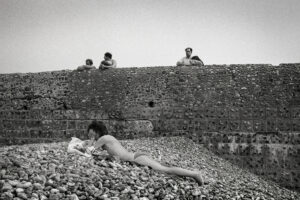My Longman Dictionary defines gaze as: ‘to fix the eyes in a steady and intent look for a short or long time’. Synonyms, such as ‘eye’ and ‘peer’, mean the same, but ‘vary widely in their motives and attitudes’. ‘Gaze may imply wonder, admiration, fascination, curiosity, and awe.’
Jean-Paul Sartre set out the concept of le regard, the gaze, in Being and Nothingness, his book of 1943. The act of gazing at another person establishes a subjective power difference experienced by both gazer and gaze, because the latter is seen as an object, not as a human being.
John Berger used the idea of the gaze in his 1972 TV series and book Ways of Seeing. He used it to explore the sexual objectification of women in paintings and photographs, arguing that men look and women are looked at as the subjects.
The concept of the male gaze as part of film theory was investigated by Laura Mulvey in an essay ‘Visual Pleasure and Narrative Cinema’ in 1975. She proposed that sexual inequality between man and women, both socially and politically, is a defining force in how the two sexes are represented on the screen.
In the photograph here, who is the gazer and who the gazee?
PS The critical use of the term ‘gaze’ was given a further twist by John Urry. His 1990 book The Tourist Gaze develops the idea that how tourists see places and people and the selection of those sights is directed and organised by the tourism industry and not simply a matter of individual and autonomous decisions.

